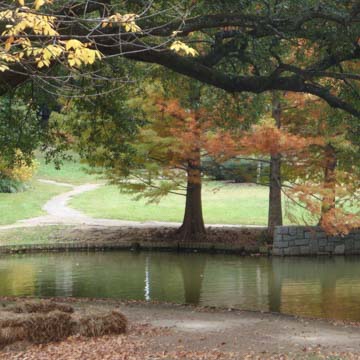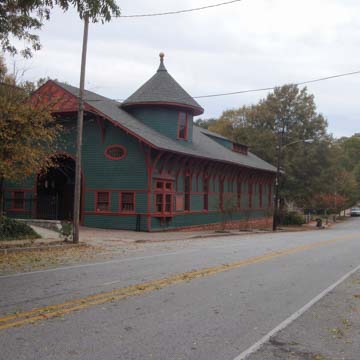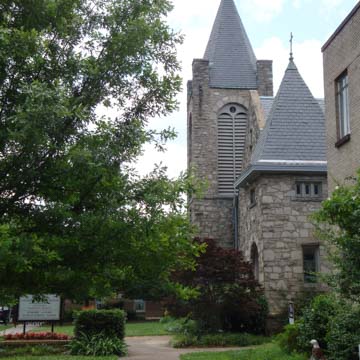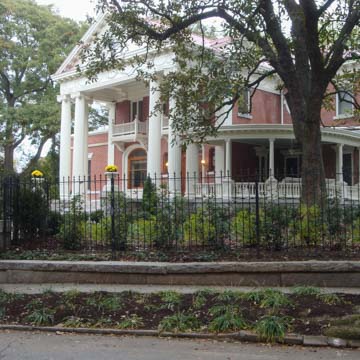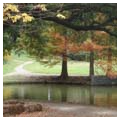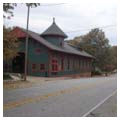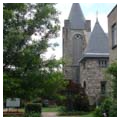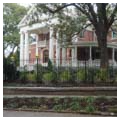Inman Park, now a rejuvenated in-town neighborhood, was developed in 1889 as a classic streetcar suburb by Joel Hurt (1850–1926), one of Atlanta’s most prominent early businessmen. Today it contains Atlanta’s best collection of late-nineteenth-century residential architecture in a variety of styles including Queen Anne, Classical Revival, American Foursquare, and Craftsman. In the late 1880s, Hurt founded the East Atlanta Land Company to purchase and develop 130 acres east of the city, and named it for his business associate, Samuel Inman. To design the new streetcar suburb, Hurt hired British landscape architect James Forsyth Johnson, who was a disciple of John Ruskin and favored curvilinear street patterns and open spaces. The centerpiece of the development was the ten-acre Springvale Park, which featured a small lake. Around the same time, Hurt also organized the Atlanta and Edgewood Street Railway Company to provide streetcar service along the tree-lined Edgewood Avenue between the new suburb and downtown.
Hurt built himself a Victorian cottage at 117 Elizabeth Street, near the end of the streetcar line, which remained his residence for a dozen years until architect W. T. Downing designed a second, more substantial, brick house on the northeast corner of the suburb’s major intersection, Euclid Avenue and Elizabeth Street. About the same time, architect George Murphy designed Callan Castle for a corner site across the street, a grand porticoed house for Coca-Cola magnate Asa Candler, built in the Classical Revival style. For much of the 1880s, Hurt encouraged prominent Atlantans to build in the new suburb he was developing, and many did: George King, the founder of King Hardware, built a residence at 889 Edgewood Avenue in 1890; the same year, Methodist minister Wilbur R. Glenn built 883 Edgewood Avenue (Bruce and Morgan); and Ernest Woodruff, officer of Coca Cola, resided at 882 Euclid Avenue in a house built in 1894 that is attributed to architect Gottfried L. Norrman. By the end of the decade, architect Willis Denny designed several notable residences in the neighborhood, and erected the Richardsonian Romanesque United Methodist Church on Edgewood Avenue, a church which most of the wealthy Inman Park residents attended. Inman Park became the first of three successive neighborhoods developed for the more well-to-do Atlantans; it was soon followed by Druid Hills, and then Peachtree Heights in Buckhead.
As automobile use increased by the mid-twentieth century, and white middle- and upper-class citizens fled the city for the suburbs, Inman Park experienced a decline. Its large mansions were subdivided into rental apartments, with some containing as many as seventeen units. In 1969, interior designer Robert Griggs and his partner Robert Aiken purchased the 1890 Beath-Dickey House (866 Euclid Avenue) and began restoration on the Queen Anne mansion. Griggs found the house divided into multiple rental units, but the interior woodwork was relatively intact, and the brick, tile, terra-cotta, shingle, and wood exterior was splendid in its tactile and rich, coloristic Victorian character. Their restoration encouraged others to notice the potential of this extraordinary neighborhood, and, stimulated by annual Inman Park Festivals, the neighborhood raised money to help fund their increasingly collective efforts: one by one houses were brought back to life and the neighborhood became the first in the city to gentrify.
The Beath-Dickey House became a symbol of the rejuvenation of Inman Park as an intown community, and of the revitalization of Atlanta as a whole. The Trolley Barn now serves as an events venue, and Atlantans flocked to the spring festivals and house tours to see mansions and bungalows, cottages and grand “painted ladies,” at various stages of restoration. The edges of the neighborhood have also begun to spawn industrial warehouse conversions, loft residential redevelopment, and New Urbanistic villages, enclaves, and retro-town house/row house developments.
References
Bazemore, Ted. “Inman Park.” New Georgia Encyclopedia. Accessed August 26, 2019. https://www.georgiaencyclopedia.org/.
“Decorator’s Hope Saves Atlanta Slum.” Toledo Blade (Toledo, OH), June 23, 1978.
Marr, Christine V., and Sharon Foster Jones. Inman Park. Charleston, SC: Arcadia Publishing, 2008.
Segrest, Eileen. “Inman Park: A Case Study in Neighborhood Revitalization.” Georgia Historical Quarterly 63 (Spring 1979): 109-117.
“Urban Pioneers Doing Well in the Slums.” Herald-Journal (Spartanburg, SC), June 24, 1978.














